On the Shoreline of Knowledge
"Arthur is proof that the art of the essay is flourishing."
Publishers Weekly (starred review), 8 Aug 2012
On the Shoreline of Knowledge is the fifth collection in Chris Arthur's critically acclaimed series of lyrical meditations. Some of the essays take ordinary objects as their point of departure — a pencil, a tropical drift seed, four rusty nails; some begin with childhood memories, or with fragments of commonplace conversation. All of them move from there into wider realms of wondering. As readers of the earlier books will have come to expect, a diverse range of material is brought into play — from Zen Buddhism in fifteenth century Japan, to how we look at paintings; from the attraction of relics, to how memory can disrupt the present; from what happens when we read, to the unlikelihood of our existence; from the ancient nest-sites of gyrfalcons, to the way we make lists. As in the previous collections, the writer speaks with an Irish accent, rooting the book in his own unique vision of the world, but he addresses elemental issues of life and death, of love and loss and remembering, giving what he says a relevance that reaches far beyond Ireland.
The title is taken from a comment of Stephen Jay Gould's in Wonderful Life: the Burgess Shale and the Nature of History (Penguin, London: 1991, pp.51-52):
People, as curious primates, dote on concrete objects that can be seen and fondled. God dwells among the details, not in the realm of pure generality. We must tackle and grasp the larger, encompassing themes of our universe, but we make our best approach through small curiosities that rivet our attention — all those pretty pebbles on the shoreline of knowledge. For the ocean of truth washes over the pebbles with every wave, and they rattle and clink with the most wondrous din.
The book includes "Chestnuts", an early version of which appeared in the Southern Humanities Review. This is how the essay begins:
Chestnuts
I
I've never met anyone immune to the appeal of chestnuts. If I did, I think they'd stir up in me a silent wave of disbelief that would soon gather into suspicion and — left unchallenged — break over into puzzled interrogation, even dislike. How could anyone not be drawn to them? Picture a rich crop of chestnuts stippling the ground beneath the trees with a dense scattering of their woody marbles. Some are naked, glistening with newness, just emerged from the cushioning white cuticle that holds them safe inside their armoured cases, as spiked on the outside as miniature medieval maces. Others have yet to hatch. Many of the cases sport hairline ruptures, or are cracked open just wide enough to reveal the enticing gleam of their smoothly voluptuous tawny cargo. Who could walk past such luscious bounty untouched by the desire to gather it?
Of course I've met plenty of people who disdain to pick them up. But this is to pretend an immunity I don't believe they possess: they feel the chestnut compulsion well enough, but have schooled themselves in resistance. Since horse chestnuts aren't edible and boast no other utility to legitimate it with a reason, many adults fear gathering them might brand them as immature, surrendering to the same susceptibility as children. In some circumstances, I feel similarly constrained myself, so one of the delights of the last several autumns has been walking with my daughter under a row of chestnuts that border a field near where we live. Her company provides all the alibi I need to obey the chestnut compulsion to the full without impugning my adult status. It's completely absorbing to spend half an hour searching the grass for the fallen cases and their already ejected payload, sometimes reaching up for those still on the tree that have ripened within reach on the lower branches.
There's at once an innocence and a kind of carnal allure about chestnuts. They draw the hand and eye with a mix of childish delight in their smooth tactile solidity, the appealing mahogany sheen of their globular rotundness, and a less easily described — or admitted to — force. It's not quite erotic, yet not quite not erotic, a sense of reaching out for little almost fleshy protuberances, swollen to nubile perfection, offering themselves up to be opened, gathered, taken, held. They're anything but wooden, despite their similarity to polished wood. They call out to be touched. In the same way that other plants have evolved complicated forms and mechanisms to render insects, birds and bats their willing slaves, pressed into the unnoticed labour of pollination or seed dispersal with the reward of fruit or nectar, I sometimes wonder if chestnuts have somehow plumbed our psychological depths and sculpted their seeds to beckon to us at a deep subliminal level that makes it difficult to ignore them. Though they often destroy them by playing conkers, generations of grubby little hands must also, surely, year on year, have transported scores of chestnuts further afield than they'd otherwise have reached.
II
It's hard to explain the exact reasons behind the appeal chestnuts exert — but such explanation isn't really necessary. Even if it's interesting to speculate about why, their appeal works on a level that makes understanding automatic, if in the end opaque. This is something instinctual, of the blood. It issues in an immediate sense of empathy, so we can feel in ourselves the gravity of their attraction even if we can't spell out the fine detail of its operation. I don't wonder in the least at my daughter — or anyone — wanting to collect them. I only have to look at my own reaction to know why this is. But I'm at a loss to explain — and in the absence of any instinctual empathy feel the need for reasons — why this same daughter took such a shine to a tweed coat of my mother's. She was drawn to it, wanted it, in the way we're drawn to chestnuts.
The easiest explanation doesn't work. She never saw my mother wearing the coat, so it wasn't just a case of associating it with someone loved, the garment representing the person who'd worn it. Her first sight of it was anything but personal. It was amongst all sorts of other garments put in clear plastic sacks and stacked in the garage beside my mother's house. This was shortly after her death when my brother and I were clearing the house and had assembled a mass of clothes to be taken to charity shops. Though it was a good coat, showing little sign of wear, it was in a style unlikely to appeal to people now. We had no use for it. Nor was the tweed in any way striking — it had no obvious feature that might arrest the eye. Had it been woven in bright colours, or been small enough to fit her, I could have better understood why it beckoned so imperiously to my daughter. A quiet, adult-size coat of unassuming quality, in a gentle mix of unobtrusive browns, discarded in a sack and stacked on a bare concrete floor alongside lots of other bagged garments — I've no idea why a six-year-old should have been so adamant she wanted it.
It's fascinating, if — as in this case — baffling, why some things speak to us with the force of commandment whilst others, often seemingly more appealing, leave us cold. In that garage full of the remnants of my mother's life, there were, to my eyes, several items that seemed more likely candidates to strike a child's fancy and call out to be retrieved. But out of all of them, Laura chose this unremarkable tweed coat. None of the other garments possessed the appeal it instantly exerted on her. Her reaction to it was precisely that of someone in thrall to the kind of magnetism that governs the human-chestnut dynamic with its iron rule of attraction.
Although at the time neither I nor my brother welcomed having items salvaged from our charity shop pile — both of us still feeling at sea with loss, overwhelmed by things and eager to get on with the practical business of jettisoning what we could — I gave in to my daughter's entreaties and kept the coat. Her victory won, she soon lost interest in it and, if truth be told, the coat, still in its plastic sack, is stowed away in our attic with a jumble of other things we don't really want or need, as forgotten as last season's chestnuts. Although it was irritating to have our selection challenged — for it risked breaching with other retrievals the dam wall of our decisions on what to dispose of and what to keep, a wall built on shaky emotional foundations — I'm glad I listened to Laura. This wasn't because of the coat itself, but because of what we found in one of its pockets...
Reviews
"For over a decade now I have delighted in reading the essays — thought-provoking, reflective and so superbly crafted that they have won numerous awards — of Chris Arthur, an Ulster-born writer now living in St Andrews ... From his books, I feel as though I know him — or at least his childhood, memories of which his essays often mine. If that makes them sound obsessively solipsistic, that couldn't be further from the truth: every time he picks up a subject, he invariably opens it out, elegising the everyday, and emphasising, in the words of one of his essays, "how truly amazing, how worthy of wonder, of consecration, our world is"... Although this is prose, it has the concentrated thought of poetry: indeed one could readily imagine a whole series of poems just from that one seed of an essay."
David Robinson, The Scotsman, Saturday 22 Sep 2012. The full text of this feature-length article/interview/review is available here.
"It isn't a book of spirituality per se, but it contains much spirituality within it. As Arthur meditates on the works of Seamus Heaney and George Eliot or the ancient nests of falcons, we travel with him into ideas that sometimes echo what he concludes elsewhere in the book — that's not a mistake but an intentional part of the book's design... As he explains in a lovely, brief prologue, the writing of his essays is like the practice of ensō, the Zen Buddhist art of drawing of circles. This process, he says, like so many other forms of meditation, draws us deeper into ourselves. There's a comfort in taking a repetitive, familiar path — even a circle — that frees the mind in other ways."
Nick Owchar, "The Siren's Call: Inner Journeys and Mental Travellers", Los Angeles Times Book Review, 25 Sep 2012
"Arthur begins with an ordinary object or action, often one with no obvious value or function — a chestnut, an old nail, picking up a pencil, scattering seeds in the garden — and moves into a sequence of associative leaps, apparently free-flowing but actually finely worked, which shuttle back and forth between personal anecdote, descriptive writing and ponderings on deep time and the meaning of it all... Arthur's essays want to inhabit more than one frame of reference simultaneously — 'How can we bring into focus a few steps taken across a lawn one springtime morning and the fourteen billion years of which such moments are a part?' ... Chris Arthur's image of the circle summarizes a mode of writing that resists summary, insisting on its ensō-like right to contain everything and nothing."
Sam Thompson, Times Literary Supplement, No.5718, 2 Nov 2012, p.8
"These essays could be considered exemplars of William Blake's world in a grain of sand, 'the depth of meaning contained in the seeming shallows of the ordinary.' But in this case objects Arthur has encountered throughout his life do not yield their vastness from within. Each grain opens up worlds of complex relationships through networks of meaning that encompass time and space. In this approach Arthur can be considered an interdisciplinary writer, integrating the findings of extensive reading and historical associations with the musings of his own imagination. ... Unique among writers of personal essays, Chris Arthur, in this new collection, as in his previous books, does not seek insights into himself or words that convey the essential drama of his life. Instead, the knowledge he pursues is a deeper understanding of his quotidian experiences... in the much greater context of the natural, historical, philosophical, and spiritual; in short, how the smallest and seemingly insignificant detail relates to the totality. In this sense, what happened to Arthur, distinct happenings, do not function as access into the man himself, but rather as representative of all our lives, starting points for exploring the connections of the personal with the world around us."
Walter Cummins, "The Worlds of the Ordinary", in Zeteo: The Journal of Interdisciplinary Writing, 8 Nov 2012. The full review may be read here.
"Writers have long been enraptured by the seemingly small and unimportant, and the habit of reading their essays has long been salubrious for me. Among contemporary writers, Irish author Chris Arthur produces work that is both relevant and revelant in its Zenlike engagement/detachment. His newest book, a collection of essays titled On the Shoreline of Knowledge: Irish Wanderings, may be characterized by this observation from 'Pencil Marks':
I've become increasingly fascinated, sometimes terrified, by the depth of meaning contained in the seeming shallows of the ordinary. Once thought about, familiar places, familiar faces, familiar things soon recede into a network of connections and associations so dense, so complex, that their familiarity is transfigured into something close to alien."
Patrick Madden, Creative Nonfiction, No.44 (Spring 2012), "Quotidian Nonfiction" (the review is available here)
"This is Arthur's fifth collection of lyrical personal essays, and in it he interweaves deeply personal reflection with philosophical meditation. Twice nominated for the Pushcart Prize, the author is perhaps the most important of the contemporary Irish essayists. As in earlier books — including Irish Nocturnes (1999) and Irish Elegies (2009) — he attempts to find the universal through careful study of the particular ... Arthur's pieces are models of the pensive, meandering literary essay, wide-ranging but never random. 'Chestnuts', for example, begins with a rumination on the appeal of chestnuts, and drifts organically to a tropical seedpod found in his mother's coat, the paths of ocean currents from the Caribbean to Ireland, the connections between the sea and grief, humans' inability to interrogate the dead, the Chandogya Upanishad, and the chestnut tree outside Anne Frank's hiding place in Amsterdam. Summing Up: Highly recommended. All readers."
C. A. Bily, Choice, January 2013 (Vol. 50 No. 5), p.472
"Chris Arthur's essays provide an example of how patient, thoughtful inquiry into one's own experience of self and world can attain highly wrought literary form. In a culture of grand theories and exaggerated claims, his is a quiet voice that deserves (and is gradually receiving) an attentive hearing. Further, the importance of his work reaches beyond the literary: he shows how the religious impulse in the individual need not involve fixed creed and sect, but can create fluid, provisional patterns of significance in a world of vociferous simplifications and conflicting belief-systems. Arthur's quest is not for a fixed identity. Paradoxically, the result of his essays is as much loss of identity as definition of it. In a way, it is the very attempt to define identity that leads to infinity. Investigating the self can lead to a sense of dissolving the self into wider and wider connectedness. There is a personal road to impersonality. As Zen teacher Dogen put it, 'To study the Buddha's way is to study the self. To study the self is to forget the self. To forget the self is to be enlightened by all things.'"
Graham Good, review of On the Shoreline of Knowledge, Southern Humanities Review, Vol.47 no.3 (2013), pp. 284–288. The full review may be read here.
"This type of writing, the essay, attempts to follow the writer's thought process, with all the meanderings, speculations, and meditations that show how the mind works. ... On the Shoreline of Knowledge contains thirteen essays that do just that... To Arthur, the act of writing an essay is an act of meditation. It's about pondering the greater questions of life calmly and honestly, not about trying to reach a destination... He searches for meaning in the small things. He turns the shallow into the deep."
Sean Ironman, review of On the Shoreline of Knowledge, The Florida Review, Volume 38, Number 1 & 2 (2013), pp. 249–251. The full review may be read here.
On the Shoreline of Knowledge can be bought from:
"The essay is epistemologically sceptical, a manifestation of the spirit of discovery at work in an uncertain universe, an exploration of a world in flux."
Paul Heilker
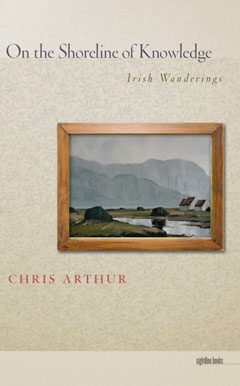
Contents
- Introduction: Going Round in Cirlces
- Chestnuts
- Lists
- Looking Behind 'Nothing's' Door
- Pencil Marks
- Kyklos
- Level Crossing
- Absent Without Leave, Leaving Without Absence
- Relics
- When Now Unstitches Then and is in Turn Undone
- Thirteen Ways of Looking at a Briefcase
- The Wandflower Ladder
- A Private View
- Zen's Bull in the Tread of Memory
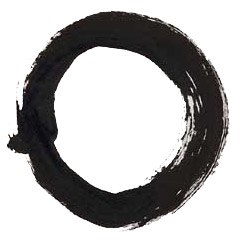
A Zen ensō. Repeated attempts to draw this empty circle are undertaken as a kind of meditation exercise by Zen practitioners. Michael Diener suggests that "only someone who is inwardly collected and in equilibrium is capable of painting a strong and well balanced circle". Arthur uses the ensō as a point of comparison for the discipline of essay writing.
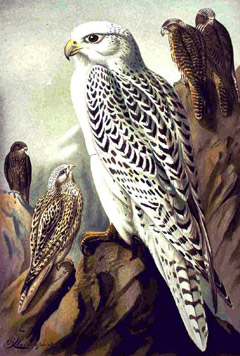
The gyrfalcon (Falco rusticolus). "Level Crossing" is a meditation on identity and naming that pivots on the discovery of how nesting sites of this bird in Greenland have recently been found to be far more ancient than previously thought. One site has been in use for over two thousand years. This illustration of gyrfalcons is from Naumann's Naturgeschichte der Vögel Mitteleuropas (Natural history of the birds of central Europe).
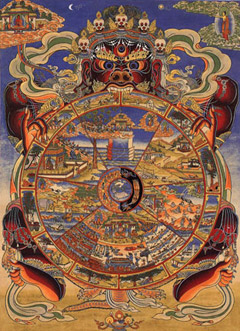
The Wheel of Life or Bhavachakra. This complex Buddhist symbol is one of the circles referred to in "Kyklos". Circles are a recurring motif in On the Shoreline of Knowledge.
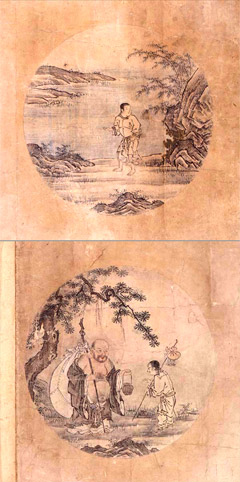
The famous sequence of Zen drawings known as the "Ox-Herding Pictures" feature in "No Heart to Look For, Even Less So a Bull", the final essay of On the Shoreline of Knowledge. There are ten pictures in the sequence. The first (top) and last (bottom) are reproduced above.
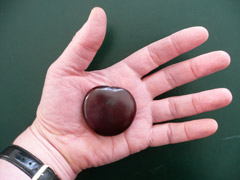
The tropical drift seed Entada scandens / Entada gigas which is the point of departure for the essay "Chestnuts".

An artist's impression of the torpedoing of the great Cunard passenger liner Lusitania, based on eye-witness accounts. The ship was sunk by a German U-boat off the coast of Ireland in 1915 with the loss of some 1200 lives. "Kyklos" includes reflection on some aspects of this tragedy.